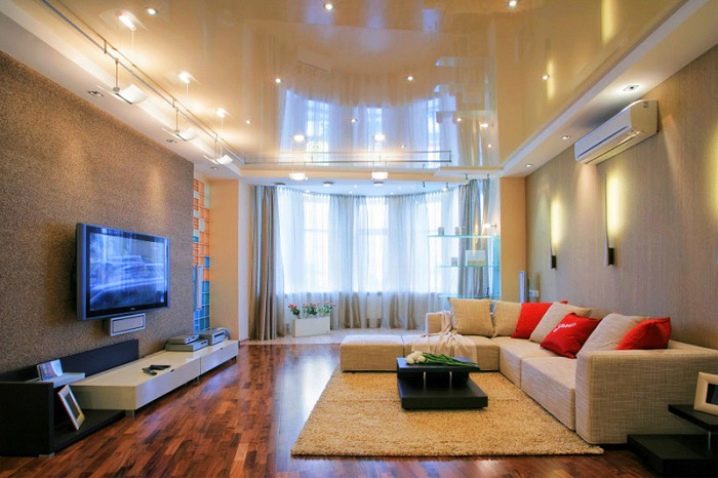Two-level stretch ceilings are one of the most popular technical solutions in interior design. This is an innovative and stylish alternative to traditional ceilings, which has many advantages. Here are some of them:
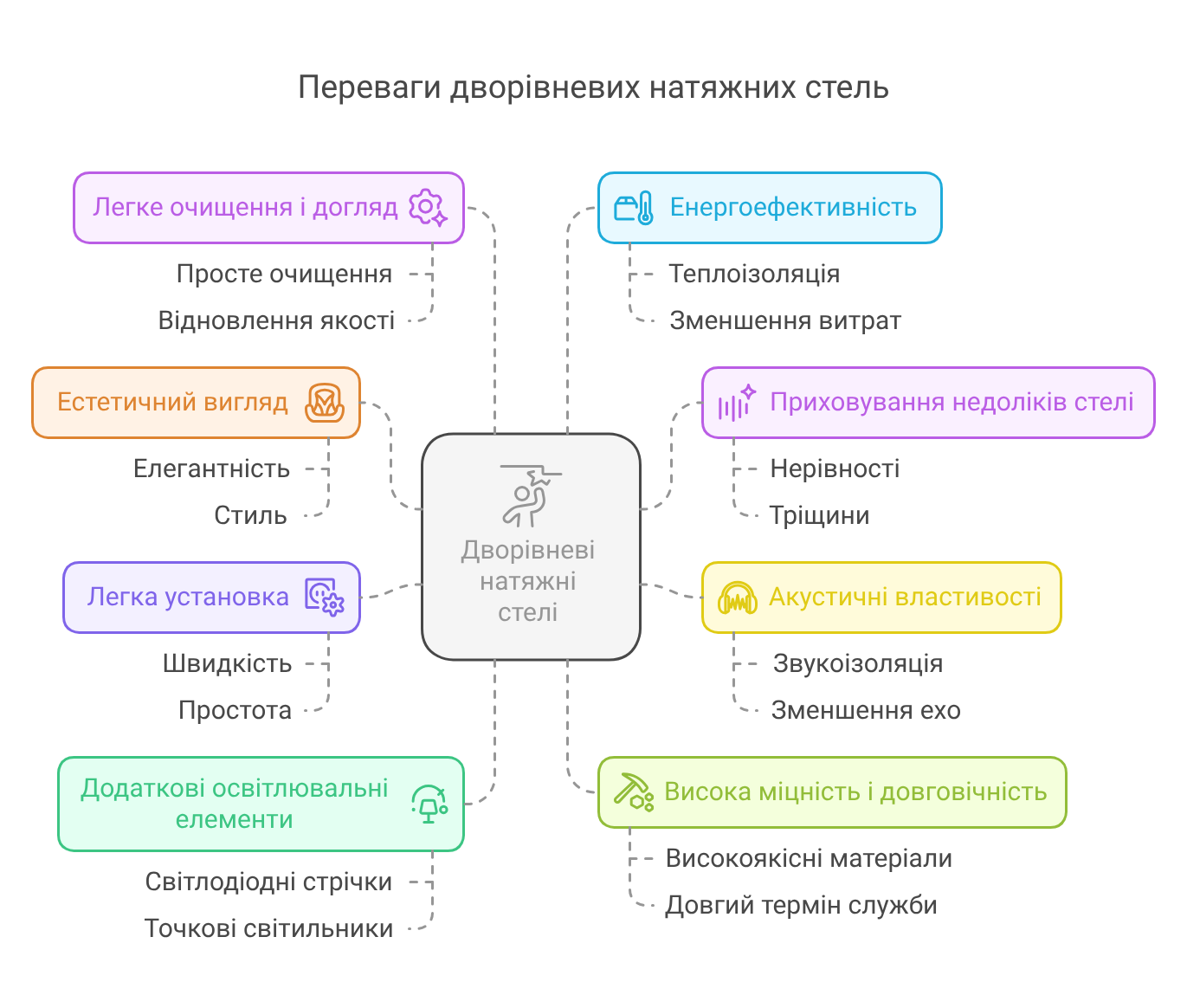
1. Aesthetic appearance: Two-level stretch ceilings create the impression of a multi-tiered space and add elegance and style to any interior. They are available in a wide range of colors, textures, and patterns, allowing you to choose the optimal solution for any design.
2. Hiding ceiling imperfections: If there are irregularities, cracks, water stains, or other damage on the ceiling, a two-level stretch ceiling can easily hide these imperfections, creating a smooth and flawless surface.
3. Acoustic properties: Two-level stretch ceilings can have a soundproofing material covering, which helps improve the acoustic characteristics of the room. They help reduce echo and noise, making them ideal for use in cinemas, conference rooms, or offices.
4. Easy installation: Installing two-level stretch ceilings is a fairly quick and simple process. Moreover, they can be installed even in already finished rooms without the need to dismantle the interior.
5. Possibility of using additional lighting elements: Two-level stretch ceilings allow for easy and effective integration of additional lighting elements, such as LED strips, spotlights, or backlighting. This allows for pleasant and cozy lighting with various light effects.
6. High strength and durability: Two-level stretch ceilings are made from high-quality materials that withstand heavy loads and have a long service life. They do not stretch, crack, or fade in the sun.
7. Easy cleaning and maintenance: Two-level stretch ceilings are easy to clean from dust, dirt, or stains. It is enough to wipe them with a soft cloth or damp napkin, and the optical quality of the surface will be restored.
8. Energy efficiency: Two-level stretch ceilings can have thermal insulation properties, which help retain heat in the room. This can lead to reduced CO2 emissions and lower energy costs for heating and air conditioning.
Using two-level stretch ceilings is not only a convenient and practical solution but also a profitable and aesthetic choice for any interior. Due to their numerous advantages, they deserve attention when arranging spaces.
Choosing the right type of stretch ceiling
Stretch ceilings are a popular ceiling design option that adds aesthetic appeal and functionality to the interior. The process of choosing the right type of stretch ceiling is an important component of a successful project. Depending on the needs and requirements of the client, various types of stretch ceilings can be selected.
Polyester stretch ceilings
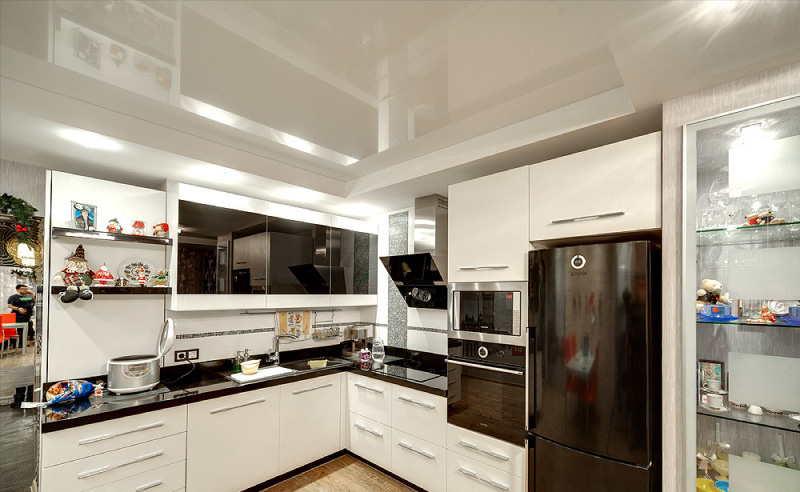
Polyester stretch ceilings are an affordable option for ordinary residential spaces. They have high strength and allow for various design solutions. Polyester stretch ceilings can be installed quickly and easily, and they are strong enough to support any type of lighting fixtures equally well.
PVC stretch ceilings
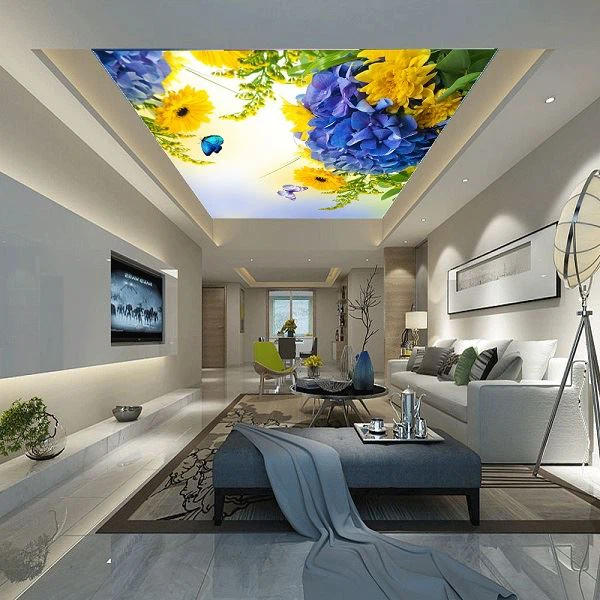
PVC stretch ceilings are a popular option due to their waterproofing and high durability. This type of stretch ceiling is actively used in bathrooms, pools, and other humid spaces. PVC stretch ceilings help prevent the formation of mold and mildew, and they easily maintain their original appearance for a long time.
Fabric stretch ceilings
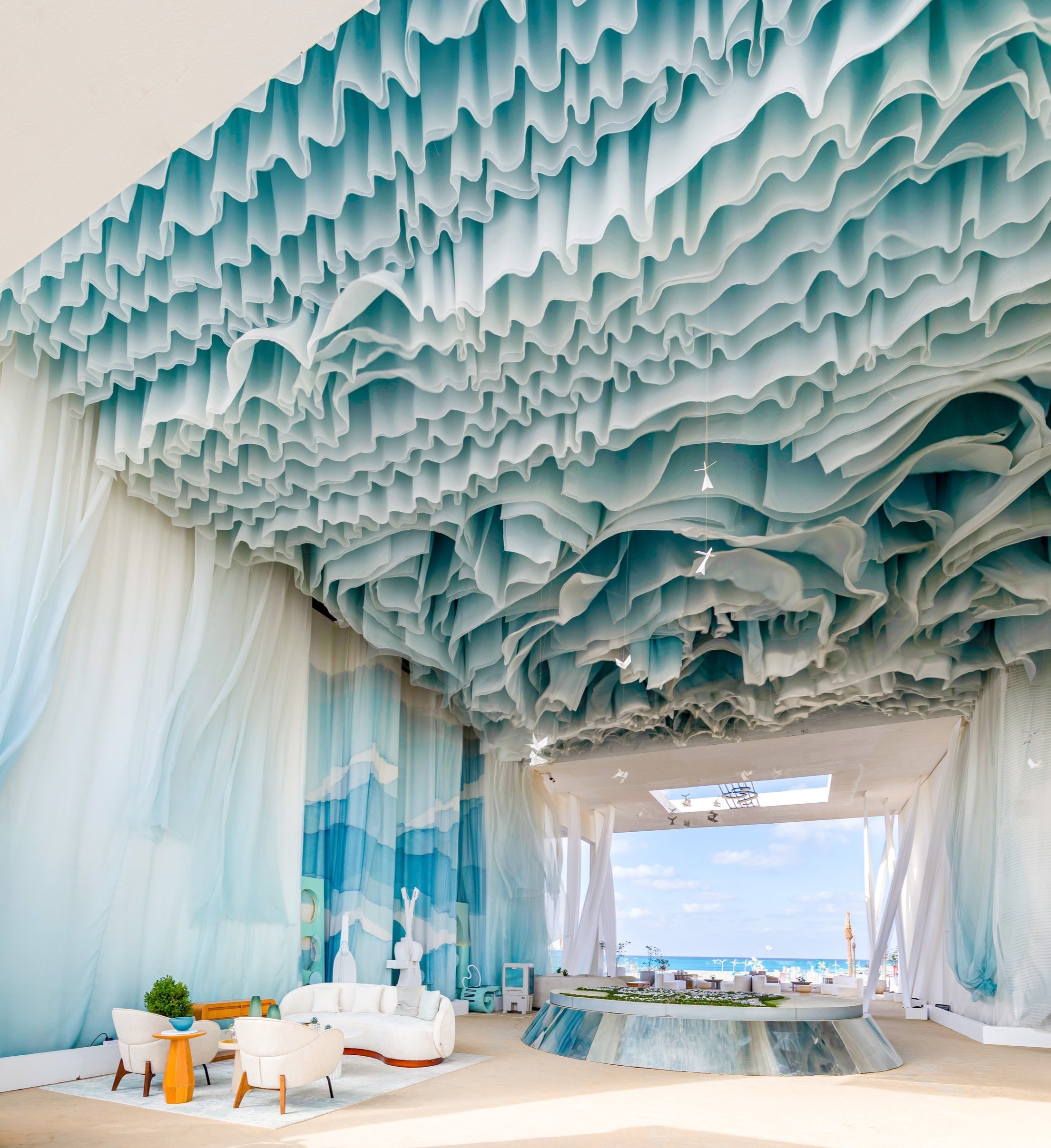
Fabric stretch ceilings can create an elegant and light appearance in the interior. They offer a wide range of colors and textures, allowing for a unique design. Fabric stretch ceilings also help regulate the acoustic quality of the room by reducing sound reflection.
Satin stretch ceilings
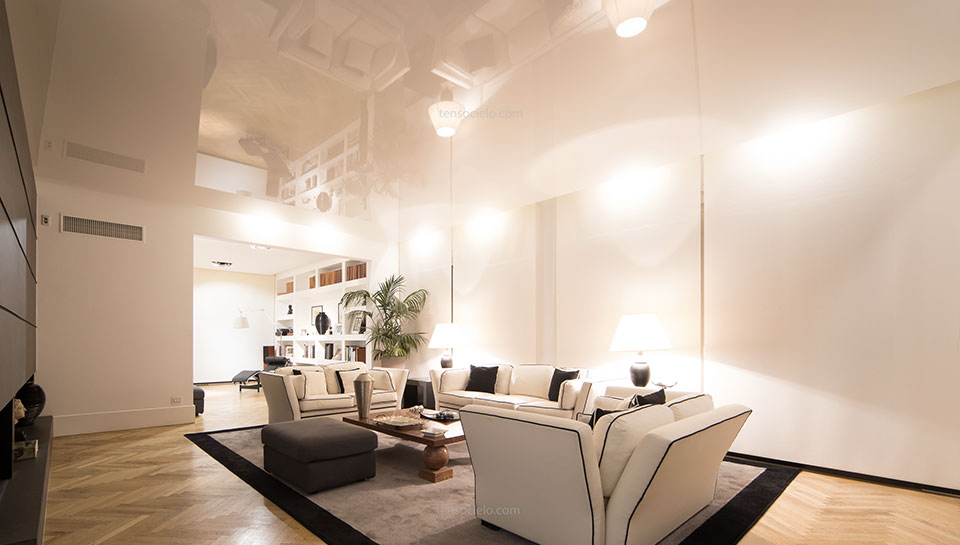
Satin stretch ceilings have a glossy texture that adds luxury and elegance to the room. They pair well with modern design styles. Satin stretch ceilings reflect light, helping to create a visual effect of backlighting and increasing the space in the room.
Matte stretch ceilings
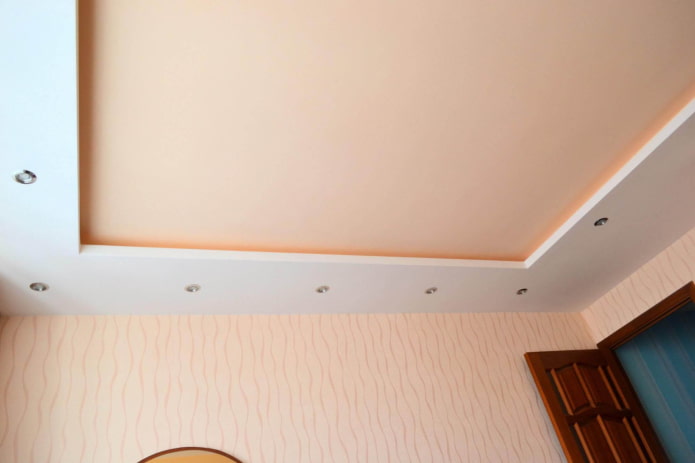
Matte stretch ceilings are a classic option that suits any interior. They have a smooth texture and matte surface, adding naturalness and aesthetics. Matte stretch ceilings diffuse light, preventing glare and reflections, making them an excellent choice for bedrooms and living rooms.
It is necessary to carefully study the requirements and features of the room before choosing the type of stretch ceiling. Considering aesthetic and functional requirements, one can find the perfect option that meets all the client’s needs.
Design and aesthetics of two-level stretch ceilings
Two-level stretch ceilings are a modern and practical solution for arranging the interior of a room. They are distinguished by their unique design and striking appearance, which adds aesthetics and comfort to the environment of any space.
Design
One of the main advantages of two-level stretch ceilings is their variability and the ability to create a unique design for each room. They can have different shades, textures, and images, allowing you to match the ceiling to any interior style.
In addition, the market offers a wide range of color solutions and material coloring for two-level stretch ceilings. This creates numerous options for experimenting with painting, graphics, and other decorative elements, allowing for the creation of a unique design that meets the individual needs and preferences of the owners.
Aesthetics
Particular attention should be paid to the aesthetic side of two-level stretch ceilings. They add effect and coziness to the room, covering possible ceiling imperfections and additionally illuminating the space. Thanks to their design, the ceiling looks more sophisticated and cozy.
Two-level stretch ceilings also provide the opportunity to create special lighting effects. With various types of backlighting, you can change the mood of the room, creating an atmosphere of tranquility, romance, or a working environment. This is especially relevant for restaurants, hotels, and other establishments where atmosphere is of great importance.
By combining design and aesthetics, two-level stretch ceilings not only give the room a new look but also improve the quality of living and working in it. They create a comfortable interior that promotes relaxation and enjoyment of being in the space.
Using color and texture in stretch ceilings
The use of color and texture in stretch ceilings is an important component of their design. Color solution and choice of texture can influence the atmosphere of the room, its style, and aesthetic appearance.
One of the key aspects of using color in stretch ceilings is creating a certain mood. Colors can affect our psychological state and emotions. Light colors often contribute to the visual expansion of space and provide a sense of brightness, while dark colors can create coziness and an intimate atmosphere. The choice of color for the stretch ceiling can depend on many factors, such as the size of the room, its purpose, interior style, and personal preferences.
In addition to color, texture also plays an important role in the design of stretch ceilings. The use of textures can add visual interest to the space and give it uniqueness. Glossy stretch ceilings can visually enlarge the space and reflect light, creating a sense of brightness. On the other hand, matte stretch ceilings can hide surface imperfections and create a pleasant subdued atmosphere.
The use of color and texture in stretch ceilings not only usually has aesthetic significance but can also influence the comfort and mood of people in the room. The choice of color and texture should be carefully considered and designed with regard to external factors and user preferences. With a wide selection of colors and textures, it is possible to create a unique interior design with a significant aesthetic effect.
Installation and setup of two-level stretch ceilings: principles and features
Installing stretch ceilings is a popular solution for interior design that allows for the creation of an aesthetic, modern, and functional space. One of the design options for stretch ceilings is the use of two-level structures, which open up many possibilities for creative space design.
Advantages of two-level stretch ceilings
Two-level stretch ceilings allow for the creation of an interesting and original design for the room. They can perform various functions, such as visually distributing space, zoning, or highlighting specific areas. Additionally, two-level ceilings allow for the placement of lighting fixtures, ventilation systems, acoustic panels, and other components in areas that are out of sight.
Stages of installation of two-level stretch ceilings
- Preparation stage:
- Installation of mounting profiles that will be used to attach the stretch ceiling rails.
- Installation of guides for the second level ceiling frame.
- Preparation of stretch ceiling rails and components.
- Installation of the first level ceiling:
- Stretching the stretch fabric on the registration profiles.
- Securing the fabric in the mounting profiles.
- Installation of the second level ceiling:
- Installation of the frame for secondary elements.
- Securing elements in the frame.
- Final stage:
- Making openings for the light fixture or other components.
- Connecting lights and other equipment.
- Checking and adjusting lighting and other systems.
Features of installing two-level stretch ceilings
Installing two-level stretch ceilings requires a certain level of experience and a professional approach. It is necessary to choose the right materials, consider the features of each room, and install the structure while adhering to all safety regulations.
Moreover, the installation of two-level stretch ceilings requires the use of special tools and knowledge of the technology for working with them. Therefore, it is recommended to consult professionals to ensure quality and safe ceiling installation.
Variations of shapes and configurations of two-level ceilings
One of the key elements of room design is the ceiling. It plays an important role in creating coziness and aesthetic appearance in the space. One of the ceiling options is the two-level ceiling, which attracts attention with its uniqueness and originality.
Two-level ceiling is a structure made up of two levels – the main and the suspended. It can have various shapes and configurations, allowing for experimentation with design and creating a unique interior.
One of the variations of shapes for two-level ceilings is round shape. It creates a visual accent in the room and adds harmony and rhythm to it. A round ceiling can be made from various materials, such as drywall, metal, or natural wood. It will emphasize the style and image of the room, for example, creating a sense of lightness and ease.
Another popular shape for a two-level ceiling is rectangular shape. It looks concise and modern, perfectly suited for rooms with rectangular or square areas. A rectangular ceiling can have various sizes and proportions, allowing you to choose the optimal option for a specific interior.
You can also highlight the echelon shape of the two-level ceiling. It gives the room sophistication and originality, creating a visual effect of depth. Such a ceiling can have different levels and heights, adding dynamism to the space and adding gravity.
Variations of shapes and configurations of two-level ceilings provide the opportunity to achieve the desired result in room design. The choice of ceiling shape depends on personal preferences, the style of the room, and its purpose. The features of the construction process and the choice of materials for the ceiling are also important. Choose the optimal option for a two-level ceiling for your interior and enjoy the created comfort and harmony.
Combining stretch ceilings with lighting: a stylish and functional solution
One of the most effective ways to utilize free space in a home or office is to install stretch ceilings with integrated lighting. This stylish and functional solution combines attractive design with practical benefits.
Stretch ceilings are tensioned structures that are installed above the main ceiling. They have properties that allow them to stretch and remain taut for a long time. This enables the creation of various shapes and solves issues with ceiling height, as well as hiding imperfections in the main ceiling.
An especially important element when installing stretch ceilings is lighting. Integrating lighting directly into the ceilings not only provides effective illumination of the room but also creates atmosphere and emphasizes the style of the decor.
The main advantages of combining stretch ceilings with lighting:
- Choice of style and design: Stretch ceilings are available in various colors, textures, and decorations, allowing you to choose the optimal solution for any interior. Integrated lighting synchronizes with the ceiling, creating a unified appearance.
- Functionality and efficiency: Lighting in stretch ceilings can be adjustable, allowing for the creation of various lighting scenarios and moods. Additionally, using LED light sources allows for energy savings.
- Hidden lighting: Integrated lighting can be located under the ceiling, creating a hidden light effect. This adds elegance to the room and allows for the creation of accents in certain areas of the space.
- Ease of installation and maintenance: The installation of stretch ceilings with lighting is performed by professionals, ensuring quality and safety of the work. Moreover, such ceilings are easy to clean and maintain, allowing them to retain their original appearance for a long time.
Combining stretch ceilings with lighting is not only a stylish solution but also economical and ecological. It provides the opportunity to create a unique atmosphere and improve the functionality of the space. This comprehensive approach to ceiling design addresses not only aesthetic but also practical tasks, making the space cozy and comfortable for living or working.
Acoustic properties of two-level stretch ceilings
The acoustic properties of two-level stretch ceilings are an important aspect of interior design, especially in spaces with special acoustic requirements, such as concert halls, cinemas, or conference rooms. These ceilings provide effective sound insulation and improve sound quality in the room.
Two-level stretch ceilings consist of a main layer located directly above the floor or ceiling, and a decorative layer positioned at a certain distance above the main layer. This design creates a dense space between the two layers, which affects sound insulation.
One of the main factors influencing the acoustic properties of two-level stretch ceilings is the materials used. Acoustic polyesters, artificial leathers, or fire-resistant materials are often used to create stretch ceilings. These materials have high acoustic permeability and can enhance sound insulation quality.
In addition to using suitable materials, the design of two-level stretch ceilings also affects their acoustic properties. The optimal distance between the main and decorative layers, as well as the use of special materials for suspending the decorative layer, can improve sound insulation and reduce resonance in the room.
The acoustic properties of two-level stretch ceilings can also be enhanced with additional accessories. For example, using acoustic panels or veneered boards can help absorb sound and reduce echo in the room.
In conclusion, the acoustic properties of two-level stretch ceilings play an important role in creating a comfortable sound environment in spaces. The use of suitable materials, optimal design, and additional accessories can contribute to improving sound quality and ensuring coziness in any room.
Thermal insulation and energy efficiency of stretch ceilings
Thermal insulation is an important component of any room, as it helps retain heat and reduce heating costs. One effective method of thermal insulation is the use of stretch ceilings, which also contribute to increasing the energy efficiency of spaces.
Stretch ceilings provide high thermal insulation due to their unique properties. They are made from special polymer materials and have low density, which allows for the creation of an air layer between the ceiling and the wall. This air layer serves as an additional insulating material and prevents heat loss from the room.
Moreover, stretch ceilings can be equipped with additional layers of thermal insulation materials, such as mineral wool or polystyrene foam. This further enhances their energy efficiency and provides additional protection against cold air.
An important advantage of stretch ceilings is their ability to prevent condensation on the ceiling surface. Condensation can occur with insufficient thermal insulation when cold air contacts a warm surface and moisture in the air condenses. Stretch ceilings can prevent this, ensuring a warm and dry atmosphere in the room.
Considering all these factors, the use of stretch ceilings leads to a significant reduction in energy consumption for heating spaces. They create an effective barrier system that helps retain heat and provides a comfortable climate inside the room.
Additionally, stretch ceilings are an aesthetically appealing solution for any interior. They allow for hiding defects and irregularities of old ceilings, as well as creating a seamless and smooth surface. With a wide selection of colors and styles, stretch ceilings allow for the creation of the desired design of the room and improve its appearance.
In summary, stretch ceilings combine both thermal insulation and aesthetic advantages. They provide effective heat retention in the room, leading to reduced heating costs, while also creating an attractive and flawless look for the interior. Choosing stretch ceilings is a rational solution for those seeking to achieve energy efficiency and stylish design in their home or office.
Ease of care and cleaning of stretch ceilings
Stretch ceilings are a stylish and practical design element that provides coziness and aesthetics in the room. In addition to their aesthetic function, they also have certain advantages in terms of ease of care and cleaning. The easy and quick process of caring for stretch ceilings is one of the main advantages that attracts many homeowners.
Convenience in cleanliness and care
Stretch ceilings are made from high-quality materials that are resistant to dirt. They reliably protect the main ceiling surface from dust, moisture, and stains. This allows for easily removing any dirt from the ceiling, enabling you to enjoy the impeccable appearance of a perfectly clean ceiling.
Simplicity of the process
Cleaning stretch ceilings is a quick and simple process. You can use ordinary soft sponges or cloths dampened in neutral cleaning agents or water. Particularly dirty spots can be cleaned with special cleaning agents that do not damage the stretch ceiling material.
No need for repairs
Thanks to high-quality materials and fastenings, stretch ceilings require virtually no repairs or improvements with proper use. Their resistance to moisture and corrosion ensures a long service life without the need for ongoing repairs or replacements.
Conclusion
Stretch ceilings meet requirements not only from the perspective of design and aesthetics but also in terms of ease of care and cleaning. Their ease of maintenance and simplicity of the process make them an ideal option for any spaces – from residential to commercial. The optimal price-to-quality ratio makes stretch ceilings a popular choice for many people. Due to these advantages, stretch ceilings become a convenient and reliable solution for creating a comfortable and stylish environment.
Using two-level stretch ceilings for zone distinction
One of the effective ways to divide space and create different zones in the interior is to use two-level stretch ceilings. This design element allows for visually highlighting each zone and adding style to the room.
Two-level stretch ceilings are a structure consisting of two levels. The first level is located lower, while the second is higher. This configuration allows for creating different ceiling heights and defining boundaries between zones.
The use of two-level stretch ceilings for zone distinction has several advantages. Firstly, it leads to a visual separation of space, which is especially important in large rooms or studio apartments without partitions. Additionally, this design allows for the use of different materials and colors for each zone, creating variety and expressiveness in the interior.
Two-level stretch ceilings can also perform lighting functions. Thanks to the ability to embed lights in the first or second level of the ceiling, various lighting effects and moods can be created in each zone. This approach allows for adjusting brightness and direction of light in different parts of the room.
Another important advantage of two-level stretch ceilings is ease of installation and maintenance. They are installed on special metal frames, which can be easily disassembled and installed with minimal effort. Moreover, the ceilings are made from waterproof materials, allowing for easy cleaning and eliminating the need for repairs or painting for a long time.
Using two-level stretch ceilings for zone distinction is one of the most effective ways to create a stylish and practical interior. It allows for defining the boundaries of each zone, creating different lighting effects, and adding variety to the space. Additionally, such ceilings provide ease of installation and operation. As a result, the application of two-level stretch ceilings becomes a beneficial choice for many interior design projects.
Hiding communications with stretch ceilings: main aspects
Stretch ceilings, as an innovative design element, are widely used to create an aesthetic and functional interior. However, as has recently been discovered, they can also be used to hide communications according to the requirements of construction and decoration of spaces.
In this section, we will examine the main aspects of hiding communications with stretch ceilings, focusing on their functionality, effectiveness, and advantages. By providing a detailed overview of the process and materials used, we will also explore various options for implementing this approach and provide examples of its successful use.
Hiding communications is an important task in various types of buildings and spaces. Typically, this is related to important aspects such as aesthetics, safety, and functionality of the premises. Stretch ceilings allow for effectively concealing various communication means, such as wiring, pipes, ventilation systems, and others.
The main advantage of using stretch ceilings in this context is their ability to provide practically invisible access to individual elements of communication equipment, thereby ensuring harmonious and unobstructed connectivity between functionality and design of the space.
When considering various options for hiding communications with stretch ceilings, it is important to take into account various factors such as the type of stretch ceiling, material, quality, and safety of the installation. Experts recommend using the services of professional installers who have experience in this field to ensure safe and effective implementation of the planned project.
In conclusion, hiding communications with stretch ceilings is a popular and practical solution for those seeking to create an aesthetic and functional space. It provides an effective and unobtrusive way to conceal various communication means, thereby creating an unobstructed zone of comfort and harmony.
*Note: Considering the individual characteristics and requirements of any building or space, it is advisable to consult relevant specialists before using stretch ceilings to hide communications for project development.
Recommendations for choosing lighting for two-level ceilings
To create comfortable and aesthetic lighting in a room with a two-level ceiling, it is important to consider various aspects and apply appropriate recommendations. Lighting not only affects convenience and safety but also adds a visual accent and helps create a certain mood in the room.
Choosing light sources
When selecting light sources for two-level ceilings, attention should be paid to their color temperature. Bright warm light (3000K-3500K) creates a cozy and subdued atmosphere, ideal for a living room or bedroom. Cool light (5000K-6000K) is brighter and stimulates the nervous system, so it is recommended for workspaces or kitchens.
It is also worth considering the way light is diffused. For ceilings with a matte surface, more diffused lighting is suitable, which helps avoid glare. For glossy ceilings, it is better to use spot lighting, which highlights their structure and appearance.
Number and placement of lights
To ensure even lighting in the room, it is important to correctly calculate the number and placement of lights. In doing so, the dimensions of the room and the height of the ceiling should be taken into account.
The optimal height for placing lights is considered to be a distance of 2.2 to 2.5 meters. A larger number of lights should be installed in work areas, while in dividing zones, a smaller number of lights can suffice.
Additional lighting elements
It is also important to consider additional lighting elements that can help emphasize the individual style of the room. These can be dimmable lights that allow for adjusting the brightness of the lighting according to needs. Accent lights can also be used to draw attention to specific details or areas in the room.
Considering individual needs
Since each room has its own characteristics and functional purpose, it is also important to consider individual needs. For example, if presentations or video conferences will be held in the room, it is advisable to choose lights with neutral light to ensure proper image quality.
Overall, the choice of lighting for two-level ceilings should depend on the functional purpose of the room, its atmospheric influence, and individual needs. By following recommendations and taking all factors into account, it is possible to create optimal and effective lighting for two-level ceilings.
Repair and maintenance of two-level stretch ceilings
In modern interior design, two-level stretch ceilings are becoming increasingly popular. They allow for creating an original and stylish look for the room, visually increasing its space and using the height of the room as effectively as possible. However, if you already have a two-level stretch ceiling installed, the question arises regarding its repair and maintenance.
Over time, the stretch ceiling may become damaged or lose its appeal. This can be caused by the structural features of the material itself, as well as external factors that may affect the condition of the ceiling.
One of the most common issues is damage to the stretch ceiling film. This can be due to mechanical damage, such as scratches or punctures, or problems related to the quality of the material. To correct such damages, it is necessary to contact specialists who deal with the repair of stretch ceilings.
Additionally, stains or water leaks may appear on the two-level stretch ceiling, especially in cases where the ceiling is near a moisture source (for example, a bathroom or kitchen). In such situations, it is necessary to carry out repairs to eliminate the causes of stains and install protective systems to avoid similar problems in the future.
To ensure proper maintenance of two-level stretch ceilings, it is recommended to consult qualified specialists. They have the necessary experience and knowledge about the features of these structures, as well as access to all necessary materials and tools. Consulting professionals will help maintain the quality and appeal of the stretch ceiling over time.
It should also be noted that regular maintenance and repair of two-level stretch ceilings can significantly reduce costs for restoration or replacement of the ceiling in case of serious damage. Professional care will extend the lifespan of the ceiling and ensure its long-lasting and reliable operation.
Do not forget that the repair and maintenance of two-level stretch ceilings should be carried out by qualified specialists. Contact professionals who have experience in this field and can guarantee the quality of the work performed. Only then can you enjoy the beauty and comfort of your two-level stretch ceiling for a long time.
Impact of two-level stretch ceilings on acoustic comfort
Excellent acoustic comfort is an important aspect of ensuring comfortable living or working in buildings. The use of two-level stretch ceilings can significantly improve acoustic comfort in spaces.
Sound insulation and sound absorption
Two-level stretch ceilings have the ability to provide effective sound insulation, helping to prevent external sounds from penetrating into the room. This is especially important for buildings located in noisy areas or near sources of external noise, such as highways or industrial enterprises.
Additionally, two-level stretch ceilings have a high capacity for sound absorption, allowing them to absorb sound within the room. This helps prevent the occurrence of echo and sound resonances, improving sound quality and overall acoustic comfort in the space.
Aesthetics and design
Two-level stretch ceilings are not only functional elements but also an important part of the room’s design. They allow for creating different levels and shapes of ceilings, adding dynamics and originality to the interior. Moreover, they can be used to create lighting or zoning in the space.
Two-level stretch ceilings can also be finished with various materials, such as fabric or plastic, adding additional aesthetic value to the room. With such a variety of options, two-level stretch ceilings easily fit into any interior and style.
Volume and sound dispersion
One of the important advantages of two-level stretch ceilings is their ability to improve sound dispersion in the room. This means that sound is evenly distributed throughout the space, avoiding the formation of “hot spots” (areas with increased sound volume) and creating a uniform acoustic field.
This is especially important in rooms where presentations, conferences, or performances are held, where sound quality is critically important. The use of two-level stretch ceilings can significantly enhance clarity and intelligibility of sound in such situations.
Trends and innovations in the design of two-level stretch ceilings
In modern design, two-level stretch ceilings are one of the most popular solutions for creating a stylish and contemporary interior. These ceilings stand out among other types of finishes for their aesthetics, functionality, and possibilities for creatively implementing design ideas.
Trends in the design of two-level stretch ceilings are constantly changing and evolving, reflecting the needs and tastes of modern consumers. One of the most relevant trends is the use of color to create accents and emotional moods. Designers are increasingly opting for bright colors that create dynamism and expressiveness in the interior.
Thanks to the continuous development of technology, various innovations have emerged in the design of two-level stretch ceilings, significantly expanding their usage possibilities. One of the most popular innovations is photo printing on ceilings. This allows for creating a ceiling with a unique design that can visually change depending on lighting and viewing angle.
Another innovation in the design of two-level stretch ceilings is the use of lighting elements. These can be lamps, LED strips, or spot lighting that adds additional depth and expressiveness to the interior.
Additionally, the use of fabric on stretch ceilings can be noted as an innovation. This allows for creating an atmospheric and cozy interior, as well as improving the sound insulation of the room.
All these trends and innovations make the design of two-level stretch ceilings more interesting, functional, and individual. The choice of specific solutions in the design of two-level stretch ceilings depends on many factors, such as the style of the room, its dimensions, and the personal preferences of the owner. Regardless of the chosen solution, the use of two-level stretch ceilings allows for creating an impressive interior with stylish accents and a comfortable atmosphere.
Frequently asked questions about two-level stretch ceilings: aesthetics and practical advantages for modern interiors
- What are two-level stretch ceilings? Two-level stretch ceilings are ceilings that consist of two levels located at different heights. They create an effect of multi-tieredness and additional depth in the interior.
- What advantages do two-level stretch ceilings have for modern interiors?
- Aesthetic appearance: two-level stretch ceilings give the interior expressiveness and originality. They can be made in various colors, textures, and shapes, allowing for a unique design.
- Creating a sense of space: due to the height difference between the two ceiling levels, it is possible to visually expand the space of the room and make it more attractive.
- Ability to hide imperfections: two-level stretch ceilings can conceal irregularities, cracks, or other defects in the main ceiling covering.
- Convenient maintenance: such ceilings are very easy to maintain and care for. They are well-suited for residential, office, and public spaces.
- What materials are used for two-level stretch ceilings? Typically, materials such as PVC film or textile canvases are used for two-level stretch ceilings. PVC film has high strength and hygiene, as well as a wide selection of colors and textures. Textile canvases provide the ceiling with softness, acoustic properties, and a good appearance.
- What criteria should be considered when choosing a two-level stretch ceiling?
- Price: the cost of two-level stretch ceilings can vary depending on the chosen material and design complexity.
- Material: it is worth choosing high-quality material that has appropriate quality certificates.
- Installer: choose an experienced company for the installation of stretch ceilings to ensure quality installation and warranty on the work performed.
- Can I install a two-level stretch ceiling myself? Installing a two-level stretch ceiling requires certain skills and specialized equipment. It is recommended to consult professionals who specialize in the installation of stretch ceilings for quality results and warranty on the work.
- How long does it take to install a two-level stretch ceiling? The installation time for a two-level stretch ceiling depends on the size and complexity of the room. On average, installation takes from a few hours to several days.
- Is it possible to disassemble a two-level stretch ceiling and move with it? Depending on the chosen material and installation method, disassembling a two-level stretch ceiling may be possible. However, disassembly and moving the ceiling may require additional costs and risks of damaging the material.
- How to care for a two-level stretch ceiling? Care for a two-level stretch ceiling usually involves using a damp cloth or soft cleaning agents. It is important to avoid using aggressive or abrasive agents that may damage the ceiling’s coating.
- What warranty is provided for two-level stretch ceilings? Warranty conditions may vary depending on the manufacturer and installer. Usually, a warranty is provided for the material and work, which can range from a few years to several decades.
- Can additional lights or ventilation be installed in a two-level stretch ceiling? Yes, a two-level stretch ceiling can be equipped with additional lights, ventilation openings, or other elements. It is important to plan these elements at the design stage and consider the structural features of the ceiling.
